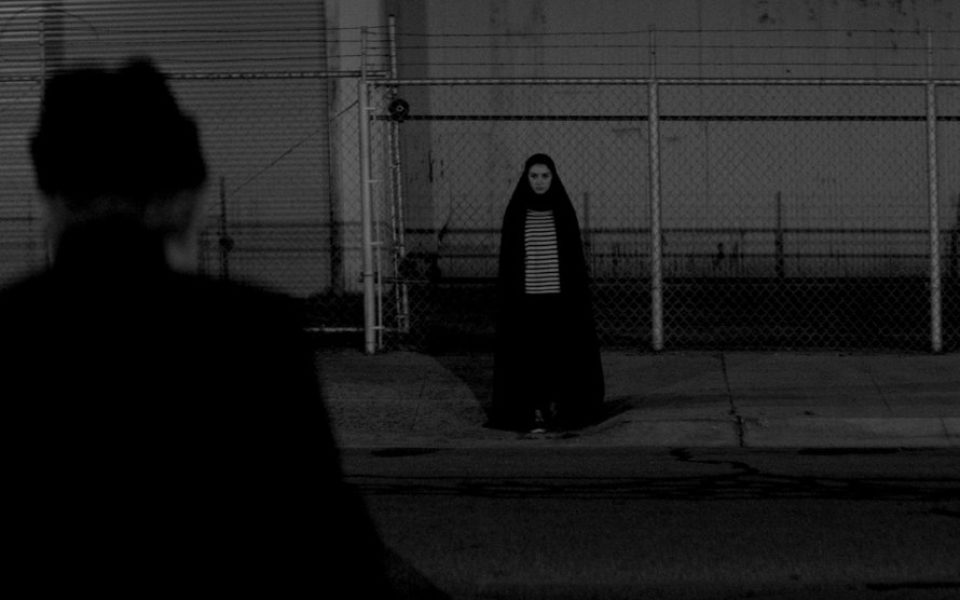by Sayaka Matsuoka
From the tween-driven Twilight series or the more serious Let the Right One In to hit shows like “True Blood” and” Vampire Diaries,” there hasn’t been a shortage of fanged entertainment in recent years. But Ana Lily Amirpour’s A Girl Walks Home Alone at Night manages to be a new take on the seemingly tired and overdone genre.
A black and white, Iranian movie with Western-style flare and feminist undertones, A Girl Walks Home Alone at Night is a vampire flick that draws heavily from German Expressionist films and is ultimately driven more by carefully thought-out cinematography than standard, bloodsucking horror. Being a very different kind of vampire movie, the film has gotten a lot of attention on both film and social-media sites. Although it is only being shown in select theaters across the country, a/perture in Winston-Salem and Geeksboro in Greensboro were among them. About 15 people piled into the basement theater at Geeksboro on Jan. 1 and while the film’s run at a/perture ended last week, it will continue this week at the Greensboro venue.
As soon as the movie begins, it’s clear that this is not going to be just another vampire movie. The opening scene begins with a handsome James Dean-esque character and a cat. The camera follows them around as the opening title is cast onto the screen and Western-style accordion music begins to play.
As the movie progresses, it becomes increasingly clear that the real triumphs and lasting impressions are created by Amirpour’s excellent directing, shooting and deliberate selection of scenes despite the categorization of the movie as one of the horror genre. This being Amirpour’s third film as a director, she draws on her previous experiences to create a film on the fringe of the vampire genre.
The film relies heavily on the framing of characters as well as the use of lighting, the movement of focus and sound. With very little dialogue spread throughout the story, the use of instrumental music played during pivotal scenes and the wide variety of pop, dance, ’80s and hip-hop music makes sound an unseen secondary character in this dramatic feature.
Although the name of the vampire is never revealed, her presence and performance as the titular “girl who walks home alone at night” leaves a harrowing impression on those watching. The vampire is cast as a beautiful yet strikingly haunting young Iranian woman, played by Sheila Vand. Amirpour infuses the film with feminist undertones as Vand lurks through the night in “Bad City,” stalking her victims who are predominantly local men who commit violent acts towards the women.
Vand wears a black chador that is common in the Iranian culture but also alludes to capes worn by vampires in older movies. She’s seen gliding in many scenes on a skateboard, creating the image of something of another world. The camera lens’ fading in and out of focus used time and time again seems to emulate the girl’s fading in and out of darkness as she socializes with people at times but then shrinks away into solitude the next scene.
The horror part of the film is demonstrated in the moments where Vand actually preys on the victims in scenes that are vivid, visceral and bloody, even in black and white. And yet Amirpour makes sure to let viewers in on the girl’s other life by showing her room, decorated with album covers of Madonna and Michael Jackson, or without the chador, engaging in her ritualistic dancing and application of makeup before going out to hunt, and her weaknesses, which include her growing relationship with the James Dean-type throughout the movie. The movie closes with the pair driving off in a car together, reminding viewers of the confusing ending of Mike Nichols’ classic movie The Graduate. Although the whole movie may be confusing or slow to some, A Girl Walks Home Alone at Night adds to the genre something darker, quirkier, and stranger than anything done as of late, and that is enough to push it forward.
Join the First Amendment Society, a membership that goes directly to funding TCB‘s newsroom.
We believe that reporting can save the world.
The TCB First Amendment Society recognizes the vital role of a free, unfettered press with a bundling of local experiences designed to build community, and unique engagements with our newsroom that will help you understand, and shape, local journalism’s critical role in uplifting the people in our cities.
All revenue goes directly into the newsroom as reporters’ salaries and freelance commissions.


Such a great article! Representing Geeksboro as it’s film curator, we are THRILLED at the positive response “A Girl Walks Home Alone at Night” is getting at our theater. Among the best films of 2014, this one is totally unique, and so popular that Geeksboro is extending it’s run of the film for all of NEXT week as well. Not only is the film a phenomenon, but the love and support that is coming from the indie film fans of the Triad is one too, and we behind the Arthouse Revival series that is hosting Amirpour’s film at Geeksboro are beaming. The success of “Girl Walks” is proof that the public demands intelligent, different, risk-taking international films, and Geeksboro is proud to supply them. We hope everyone has a chance to check out this film, and thanks again to Sayaka Mitsuoka for her timely review.